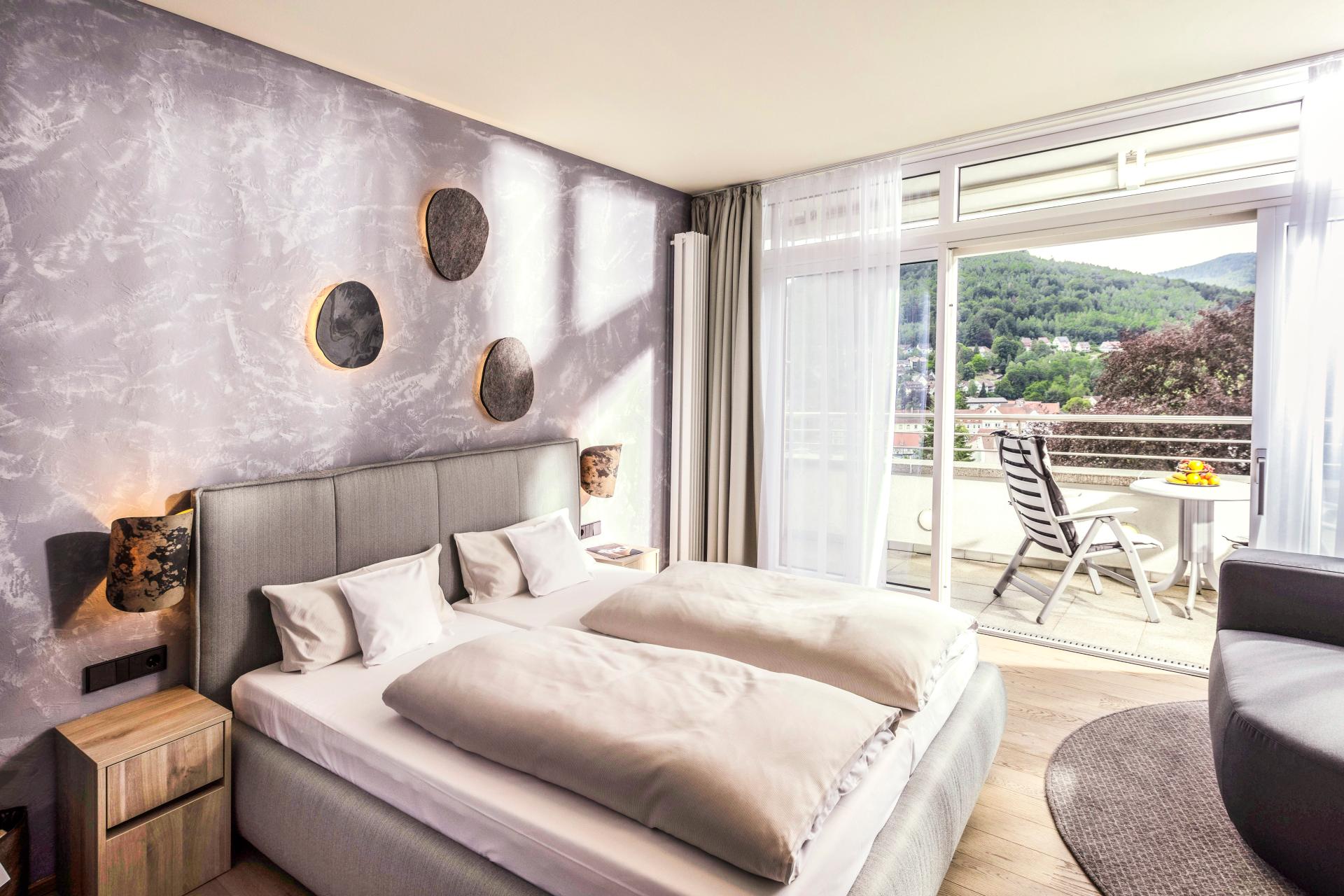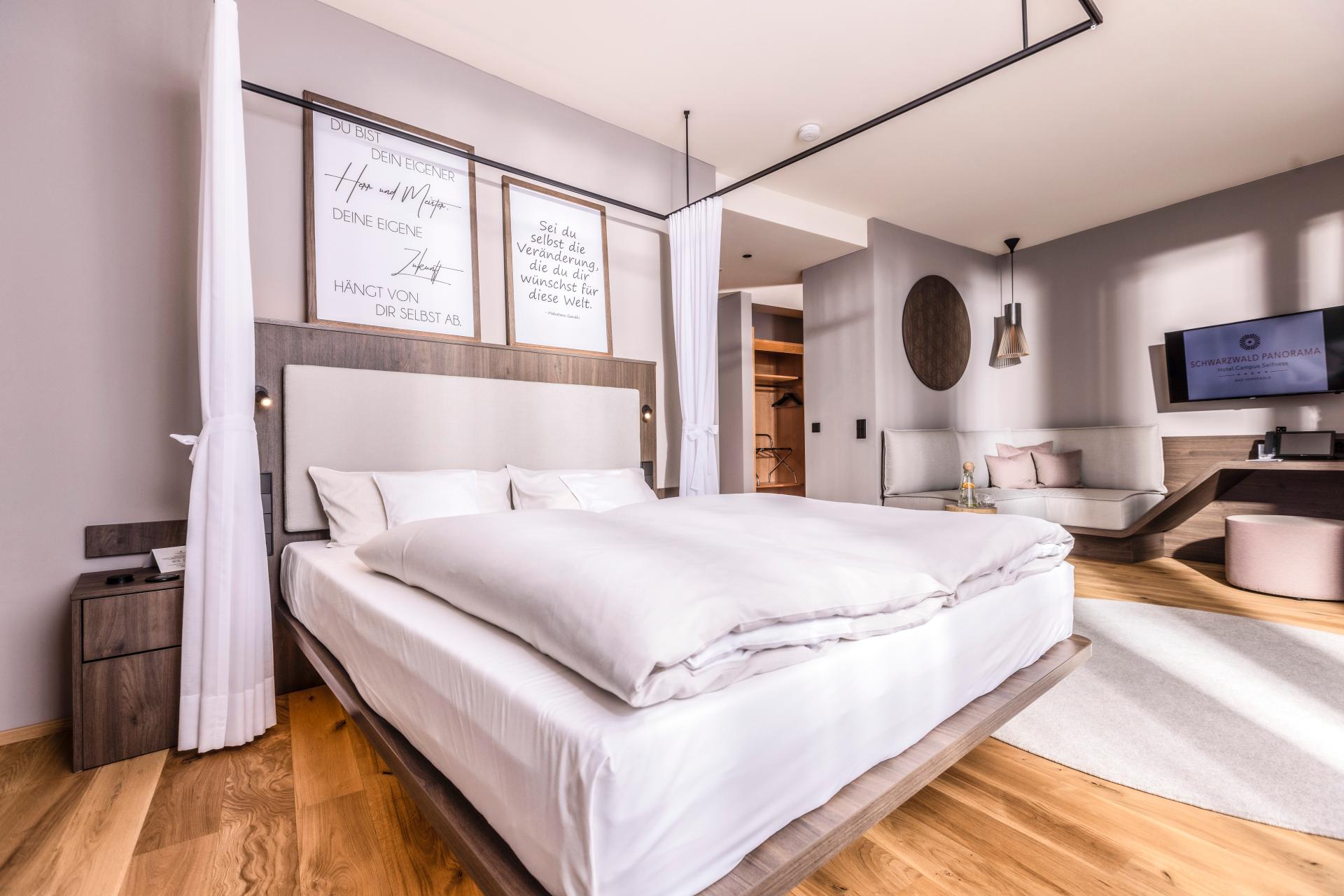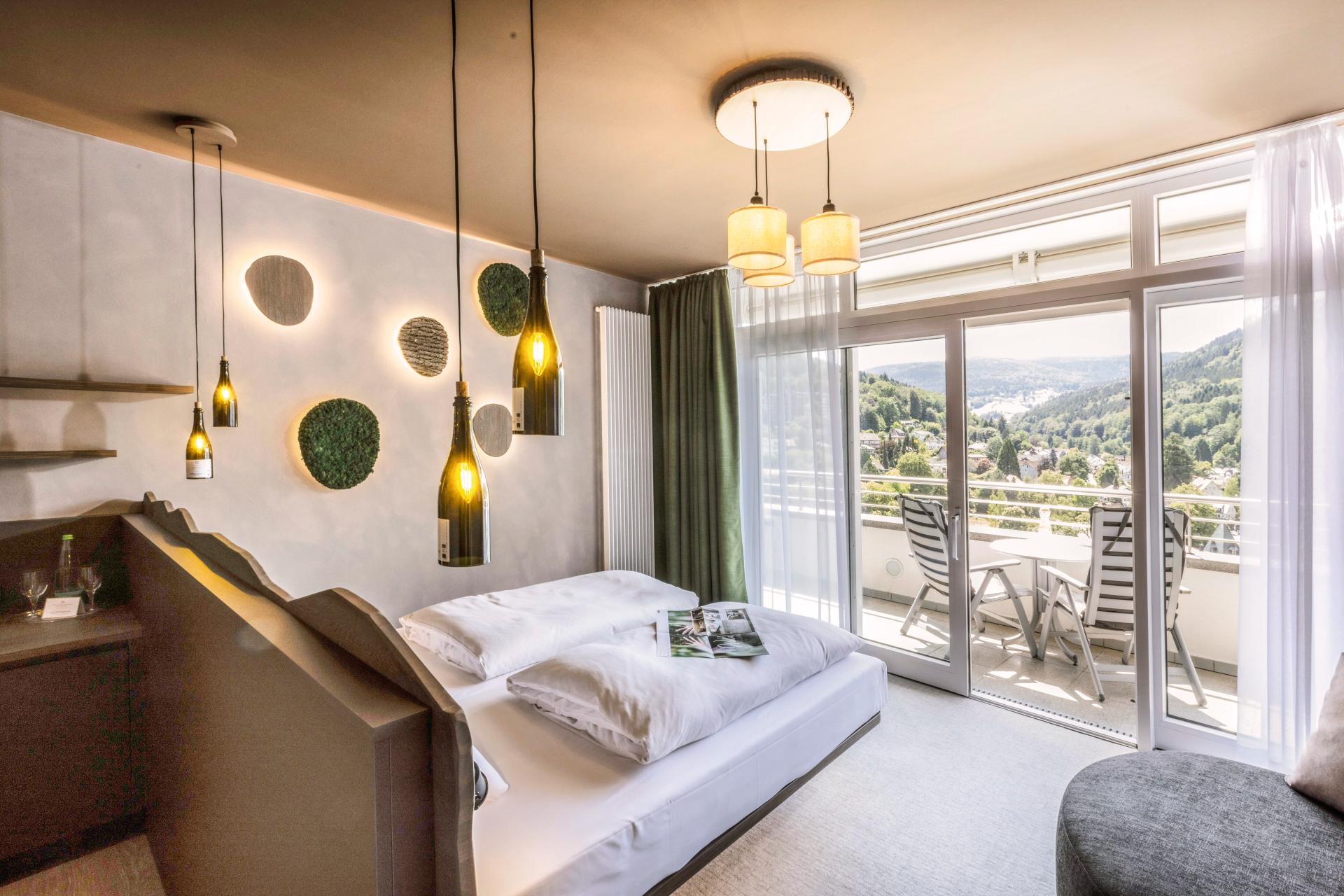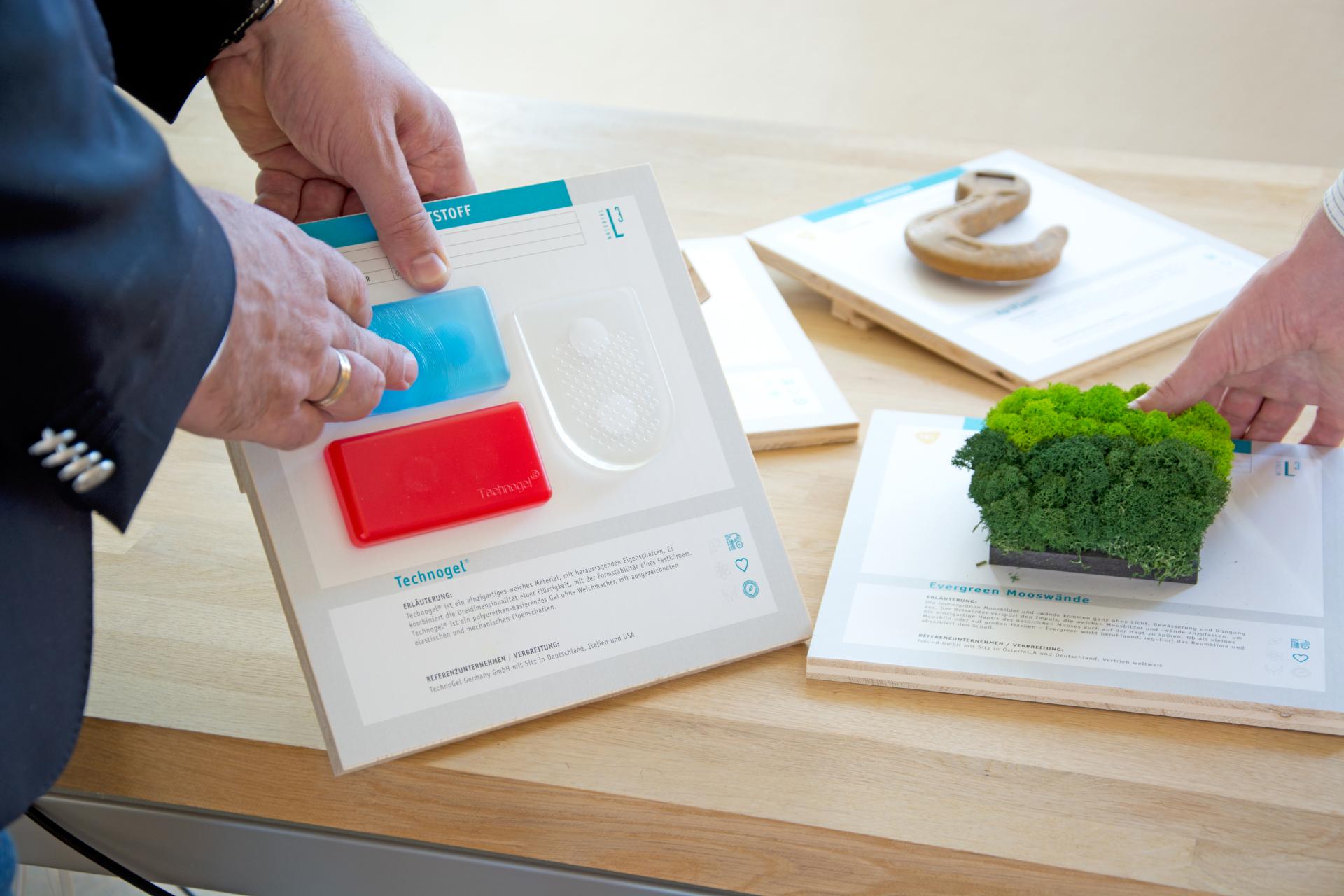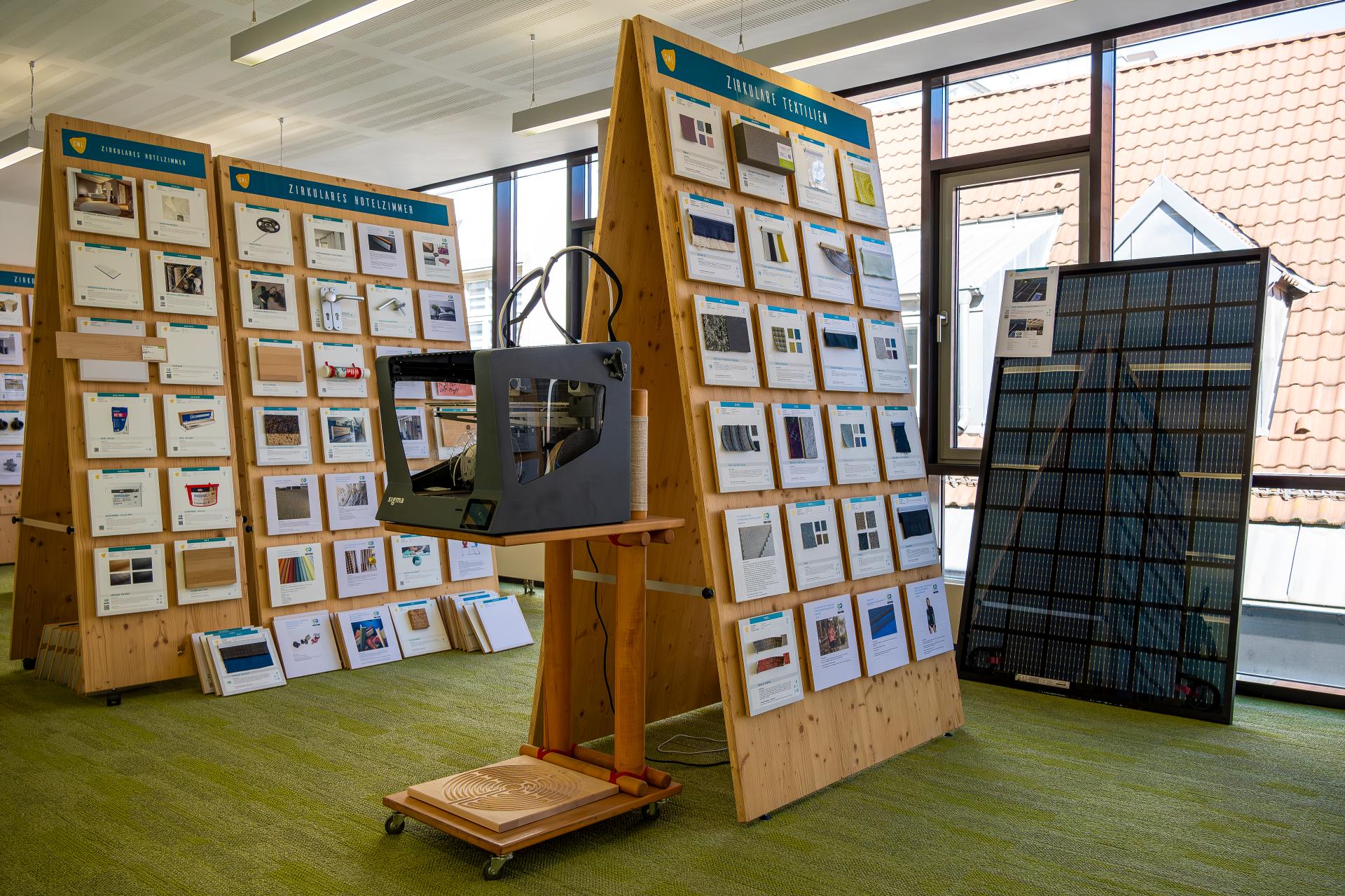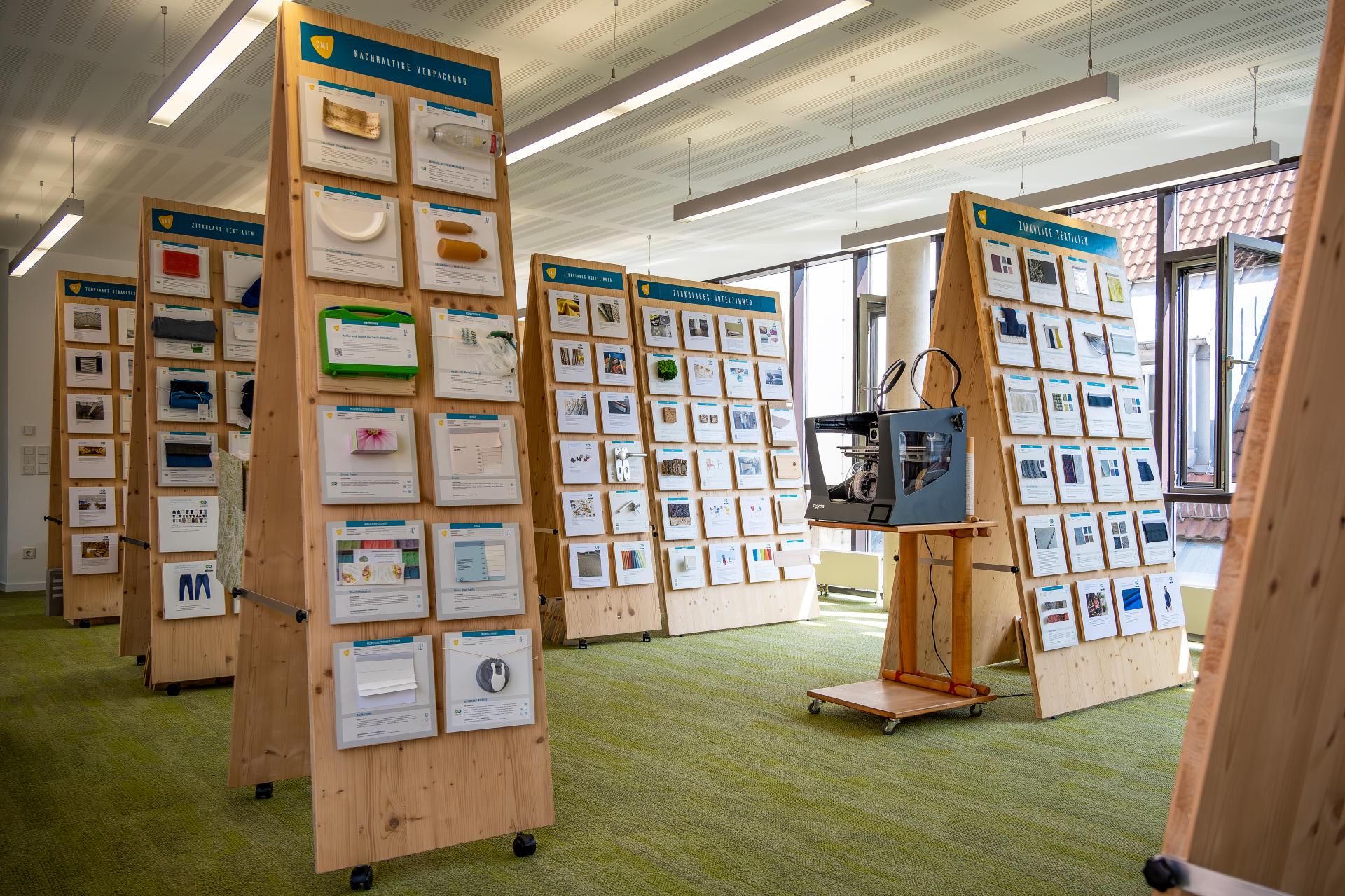The Circular Material Lab
Basic information
Project Title
The Circular Material Lab
Full project title
From Lab to Living: Material Innovation and Application in the Circular Living Hotel
Category
Shaping a circular industrial ecosystem and supporting life-cycle thinking
Project Description
In a world where sustainability is no longer a choice but a necessity, the "Circular Living" hotel rooms stand as living testaments to the power and potential of the circular economy. These rooms are intricately designed using materials from the esteemed Circular Material Lab by RITTWEGER und TEAM, which boasts an extensive library of over 400 materials suitable for the circular economy. The materials used in the rooms are selected based on a stringent set of criteria.
Geographical Scope
National
Project Region
Germany
Urban or rural issues
Mainly urban
Physical or other transformations
It refers to a physical transformation of the built environment (hard investment)
EU Programme or fund
No
Description of the project
Summary
The Circular Material Lab project aims to facilitate the transition towards a circular economy through innovative material use and design. Its target groups include companies and industries seeking sustainable transformation. The project's objectives are to promote the use of reusable materials, foster interdisciplinary material innovation, and accelerate decarbonisation at the material level. Achieved outcomes include the establishment of a comprehensive material library and the development of the Circular Living Hotel rooms as a practical example of the Lab's principles in action. This project is exemplary in promoting sustainable practices and life-cycle thinking within the context of circular industrial ecosystems.
The Circular Living Hotel rooms case study being a tangible, living example of what’s possible when utilising the Circular Material Lab, also aims to inspire and motivate guests to adopt sustainable practices and to raise awareness about the importance of sustainability in the hospitality industry.
The objectives of the project are to implement circular economy principles and Cradle to Cradle design concepts to minimise waste and maximise the use of renewable resources.
The project seeks to create a new business model that brings clear benefits in terms of sustainability and circularity, as well as in terms of quality of life for all and design for all. This was achieved by, designing three unique hotel room interiors using circular material from the RITTWEGER & TEAM Circular Material Lab.
Target Groups:
Sustainability managers
Consultants for regenerative economics (e.g. sustainability, circular economy)
Executives of SMEs, banks, and finance industry
NGO’s
Start ups
Clinic management
Architects
Designers
Engineers and developers
Students, children, young learners
The Circular Living Hotel rooms case study being a tangible, living example of what’s possible when utilising the Circular Material Lab, also aims to inspire and motivate guests to adopt sustainable practices and to raise awareness about the importance of sustainability in the hospitality industry.
The objectives of the project are to implement circular economy principles and Cradle to Cradle design concepts to minimise waste and maximise the use of renewable resources.
The project seeks to create a new business model that brings clear benefits in terms of sustainability and circularity, as well as in terms of quality of life for all and design for all. This was achieved by, designing three unique hotel room interiors using circular material from the RITTWEGER & TEAM Circular Material Lab.
Target Groups:
Sustainability managers
Consultants for regenerative economics (e.g. sustainability, circular economy)
Executives of SMEs, banks, and finance industry
NGO’s
Start ups
Clinic management
Architects
Designers
Engineers and developers
Students, children, young learners
Key objectives for sustainability
The Circular Material Lab by RITTWEGER und TEAM is dedicated to fostering sustainable resource use and the transition to a circular economy. It aids companies in conceptualising material cycles and utilising reusable materials. The initiative stems from understanding that hands-on interaction with materials leads to a deeper comprehension of ecological interconnections, counteracting the linear economy's single-use resource habit, which is crucial for transitioning to a climate-neutral society.
A tangible material library comprising over 400 materials suitable for the Circular Economy facilitates this, contributing to the challenges of sustainable transformation in companies and aligning with the EU Green Deal's goal to reduce environmental impact and mitigate climate change effects.
The project's objectives are to integrate interdisciplinary material innovations, accelerate decarbonisation at the material level, provide a multiplicative platform for material innovators, foster new perspectives on materials in decarbonisation, and make visible the value of material health, circularity, social standards, water, and energy consumption. These efforts contribute to the broader scope of the EU Green Deal, aiming for a climate-neutral European Union by 2050 and enhancing air and water quality, promoting circular economy, and strengthening biodiversity.
The Circular Living Hotel rooms exemplifies the application of Circular Material Lab's principles by incorporating fully reusable interior furnishings that align with Circular Economy and Cradle to Cradle® design principles. The approach aims to reduce waste and environmental impact without sacrificing quality and individuality, thus setting new sustainability benchmarks in the hospitality industry.
The key objectives of the Circular Living Hotel rooms are to promote sustainability and circularity in the hospitality industry by implementing circular economy principles and Cradle to Cradle design concepts.
A tangible material library comprising over 400 materials suitable for the Circular Economy facilitates this, contributing to the challenges of sustainable transformation in companies and aligning with the EU Green Deal's goal to reduce environmental impact and mitigate climate change effects.
The project's objectives are to integrate interdisciplinary material innovations, accelerate decarbonisation at the material level, provide a multiplicative platform for material innovators, foster new perspectives on materials in decarbonisation, and make visible the value of material health, circularity, social standards, water, and energy consumption. These efforts contribute to the broader scope of the EU Green Deal, aiming for a climate-neutral European Union by 2050 and enhancing air and water quality, promoting circular economy, and strengthening biodiversity.
The Circular Living Hotel rooms exemplifies the application of Circular Material Lab's principles by incorporating fully reusable interior furnishings that align with Circular Economy and Cradle to Cradle® design principles. The approach aims to reduce waste and environmental impact without sacrificing quality and individuality, thus setting new sustainability benchmarks in the hospitality industry.
The key objectives of the Circular Living Hotel rooms are to promote sustainability and circularity in the hospitality industry by implementing circular economy principles and Cradle to Cradle design concepts.
Key objectives for aesthetics and quality
The cultural benefits of the Circular Material Lab project are intertwined with its commitment to sustainable practices and design principles that foster a deeper understanding and appreciation of ecological interrelations.
The project promotes the use of materials that not only align with environmental sustainability but also prioritise material health, thereby enhancing the cultural landscape through its commitment to aesthetically appealing and sustainable design solutions.
This approach not only encourages a shift in how materials are perceived and used but also supports a cultural shift towards sustainability and responsible resource use, aligning with a broader societal move towards environmental consciousness and action.
The quality of experience for people within the Circular Hotel Rooms is exemplary because not only are the materials sustainable, but also healthy (non-toxic), ensuring strict material compliance. In addition, the interior design is of a high standard, which demonstrates that sustainable approaches can enhance rather than lower aesthetics. This project demonstrates these two qualities as not being mutually exclusive, but rather in harmony.
These special rooms, encourage reflection, while also supporting relaxation, thanks to the intentional interior design aesthetics, and the specific choice of materials (thanks to the application of the Circular Lateral Lab), that are based on several criteria. The strict evaluation criteria, are based on the highest global quality standards for eco-effectiveness and include:
1. Material health
2. Circularity
3. Climate neutrality
4. Decarbonisation
5. Social standards
6. Water and soil conservation
These criteria were selected to ensure that the hotel room is not only sustainable but also promotes the health and well-being of guests. By selecting materials that are free from harmful chemicals and toxins, the hotel room can provide a healthy and safe environment for guests.
The project promotes the use of materials that not only align with environmental sustainability but also prioritise material health, thereby enhancing the cultural landscape through its commitment to aesthetically appealing and sustainable design solutions.
This approach not only encourages a shift in how materials are perceived and used but also supports a cultural shift towards sustainability and responsible resource use, aligning with a broader societal move towards environmental consciousness and action.
The quality of experience for people within the Circular Hotel Rooms is exemplary because not only are the materials sustainable, but also healthy (non-toxic), ensuring strict material compliance. In addition, the interior design is of a high standard, which demonstrates that sustainable approaches can enhance rather than lower aesthetics. This project demonstrates these two qualities as not being mutually exclusive, but rather in harmony.
These special rooms, encourage reflection, while also supporting relaxation, thanks to the intentional interior design aesthetics, and the specific choice of materials (thanks to the application of the Circular Lateral Lab), that are based on several criteria. The strict evaluation criteria, are based on the highest global quality standards for eco-effectiveness and include:
1. Material health
2. Circularity
3. Climate neutrality
4. Decarbonisation
5. Social standards
6. Water and soil conservation
These criteria were selected to ensure that the hotel room is not only sustainable but also promotes the health and well-being of guests. By selecting materials that are free from harmful chemicals and toxins, the hotel room can provide a healthy and safe environment for guests.
Key objectives for inclusion
Circular Material Lab
The Circular Material Lab exemplifies inclusivity through its open-door policy, welcoming organised groups from diverse sectors of the public to visit and engage with its innovative sustainability practices, thereby fostering a community-wide understanding and appreciation of ecological stewardship and material health.
The principles of circular design inherently promote inclusion by enabling accessibility and affordability through sustainable material use and lifecycle thinking. The Lab's vast material library encourages innovation and supports companies in transitioning towards a circular economy, which can indirectly contribute to creating more inclusive products and services.
The Circular Material Lab actively invites material suggestions, embracing a collaborative approach to innovation; each proposal undergoes a rigorous assessment for material compliance before being potentially incorporated into the lab's ever-evolving sustainable portfolio.
Circular Living Hotel Rooms
Accessibility and Design for All: The use of natural materials and the creation of a harmonising atmosphere through design elements like the "Flower of Life" suggest an environment that is not only physically accessible but also designed to be psychologically welcoming and calming for all guests.
Affordability widens audience: The project's sustainable approach, by potentially reducing long-term operational costs, could allow for more competitive pricing, making the hotel experience accessible to a broader demographic.
The Circular Material Lab exemplifies inclusivity through its open-door policy, welcoming organised groups from diverse sectors of the public to visit and engage with its innovative sustainability practices, thereby fostering a community-wide understanding and appreciation of ecological stewardship and material health.
The principles of circular design inherently promote inclusion by enabling accessibility and affordability through sustainable material use and lifecycle thinking. The Lab's vast material library encourages innovation and supports companies in transitioning towards a circular economy, which can indirectly contribute to creating more inclusive products and services.
The Circular Material Lab actively invites material suggestions, embracing a collaborative approach to innovation; each proposal undergoes a rigorous assessment for material compliance before being potentially incorporated into the lab's ever-evolving sustainable portfolio.
Circular Living Hotel Rooms
Accessibility and Design for All: The use of natural materials and the creation of a harmonising atmosphere through design elements like the "Flower of Life" suggest an environment that is not only physically accessible but also designed to be psychologically welcoming and calming for all guests.
Affordability widens audience: The project's sustainable approach, by potentially reducing long-term operational costs, could allow for more competitive pricing, making the hotel experience accessible to a broader demographic.
Results in relation to category
The Circular Material Lab has achieved several outcomes related to shaping a circular industrial ecosystem and supporting life-cycle thinking:
Innovation in Material Use: It has developed a library of over 400 materials, encouraging the adoption of sustainable resources in industries.
Lifecycle Reduction of Carbon Footprint: The project's focus on decarbonisation through material selection directly supports the reduction of Scope 3 emissions.
Education and Cultural Shift: By promoting an understanding of material cycles, the project fosters a cultural shift towards circularity and sustainability.
Economic Benefits: The adoption of circular principles can lead to cost savings for businesses through resource efficiency and waste reduction.
Environmental Impact: Reduced waste and extended product lifecycles contribute to lower environmental impact.
Results Produced From Utilisation of the Circular Material Lab:
Three high quality and furnished hotel rooms currently available for booking. Boasting not only material health in terms of non toxic and sustainability but also circular economically viabilities which also offer unique experiences to guests of wellbeing and harmony.
The first (of many) Large scale, tangible project case studies to emerge from RITTWEGER und TEAM’s Circular Material Lab.
Innovation in Material Use: It has developed a library of over 400 materials, encouraging the adoption of sustainable resources in industries.
Lifecycle Reduction of Carbon Footprint: The project's focus on decarbonisation through material selection directly supports the reduction of Scope 3 emissions.
Education and Cultural Shift: By promoting an understanding of material cycles, the project fosters a cultural shift towards circularity and sustainability.
Economic Benefits: The adoption of circular principles can lead to cost savings for businesses through resource efficiency and waste reduction.
Environmental Impact: Reduced waste and extended product lifecycles contribute to lower environmental impact.
Results Produced From Utilisation of the Circular Material Lab:
Three high quality and furnished hotel rooms currently available for booking. Boasting not only material health in terms of non toxic and sustainability but also circular economically viabilities which also offer unique experiences to guests of wellbeing and harmony.
The first (of many) Large scale, tangible project case studies to emerge from RITTWEGER und TEAM’s Circular Material Lab.
How Citizens benefit
Circular Material Lab: The hotel's sustainable practices have been enhanced by interfacing with the Circular Material Lab, which stands to serve as a hub for innovation and education where citizens, businesses, and civil society can learn about and contribute to circular economy practices. It is here to act as a platform for stakeholders to collaborate on new methods of reducing waste and emissions, thus amplifying the project's impact.
Resource Efficiency: By choosing recyclable materials, the project promotes a circular economy that benefits local citizens by conserving resources. This approach ensures that the natural resources used are not wasted but are kept in circulation for as long as possible, reducing the need for extraction of new materials and thereby preserving them for future generations.
Environmental Benefits: The project's focus on reducing emissions through the use of recyclable materials aligns with the interests of civil society groups concerned with environmental sustainability. Scope 3-related CO2e emissions in production mean a smaller carbon footprint for the hotel, which contributes to cleaner air and a healthier environment for the local community.
Economic Incentives: The take-back agreements with suppliers and manufacturers not only ensure the recyclability of materials but also support a local and regional economy that is based on sustainability. This can lead to job creation in recycling and remanufacturing sectors, which benefits the economy at various levels.
Educational Value: The project can serve as an educational model for citizens and other businesses, demonstrating the viability and benefits of sustainable practices. This can inspire others to adopt similar methods, leading to widespread impact beyond the initial project.
Social Responsibility: By engaging in a project that prioritises the environment and resource preservation, citizens and civil society organisations become part of a larger movement towards sustainability.
Resource Efficiency: By choosing recyclable materials, the project promotes a circular economy that benefits local citizens by conserving resources. This approach ensures that the natural resources used are not wasted but are kept in circulation for as long as possible, reducing the need for extraction of new materials and thereby preserving them for future generations.
Environmental Benefits: The project's focus on reducing emissions through the use of recyclable materials aligns with the interests of civil society groups concerned with environmental sustainability. Scope 3-related CO2e emissions in production mean a smaller carbon footprint for the hotel, which contributes to cleaner air and a healthier environment for the local community.
Economic Incentives: The take-back agreements with suppliers and manufacturers not only ensure the recyclability of materials but also support a local and regional economy that is based on sustainability. This can lead to job creation in recycling and remanufacturing sectors, which benefits the economy at various levels.
Educational Value: The project can serve as an educational model for citizens and other businesses, demonstrating the viability and benefits of sustainable practices. This can inspire others to adopt similar methods, leading to widespread impact beyond the initial project.
Social Responsibility: By engaging in a project that prioritises the environment and resource preservation, citizens and civil society organisations become part of a larger movement towards sustainability.
Physical or other transformations
It refers to a physical transformation of the built environment (hard investment)
Innovative character
The innovative character of the Circular Material Lab lies in its comprehensive approach to material-focused decarbonisation.
Instead of focusing on individual aspects of sustainability like many mainstream initiatives, this project presents a comprehensive approach by featuring over 400 circular material samples, a significant number of which hold Cradle to Cradle certification. This collection plays a key role in revolutionising supply chains and contributes to decarbonisation by enabling carbon storage in long-lasting products.
The project stands out by binding carbon in materials, which, combined with the circular economy's reduction of Scope 3 carbon emissions, offers businesses a substantial contribution towards a circular economy, showcasing innovation beyond conventional practices.
Innovative character of the Circular Living Hotel rooms, can be highlighted in comparison to mainstream actions in the hospitality industry in several ways:
Health-Conscious Choices: The project places a strong emphasis on creating a healthy living environment, which is an innovative approach in an industry that often prioritises visual appeal and luxury over health and wellness.
Circular Economy Focus: At the heart of the project's innovation is its emphasis on circularity. The Material Lab prioritises materials that come with a 'taking back agreement' from suppliers and manufacturers. This ensures that materials and products are brought back into the cycle at the end of their lifespan, creating a closed-loop circular economy. This approach, prioritising the reuse and recycling of resources, significantly differentiates the project from mainstream industry practices.
Instead of focusing on individual aspects of sustainability like many mainstream initiatives, this project presents a comprehensive approach by featuring over 400 circular material samples, a significant number of which hold Cradle to Cradle certification. This collection plays a key role in revolutionising supply chains and contributes to decarbonisation by enabling carbon storage in long-lasting products.
The project stands out by binding carbon in materials, which, combined with the circular economy's reduction of Scope 3 carbon emissions, offers businesses a substantial contribution towards a circular economy, showcasing innovation beyond conventional practices.
Innovative character of the Circular Living Hotel rooms, can be highlighted in comparison to mainstream actions in the hospitality industry in several ways:
Health-Conscious Choices: The project places a strong emphasis on creating a healthy living environment, which is an innovative approach in an industry that often prioritises visual appeal and luxury over health and wellness.
Circular Economy Focus: At the heart of the project's innovation is its emphasis on circularity. The Material Lab prioritises materials that come with a 'taking back agreement' from suppliers and manufacturers. This ensures that materials and products are brought back into the cycle at the end of their lifespan, creating a closed-loop circular economy. This approach, prioritising the reuse and recycling of resources, significantly differentiates the project from mainstream industry practices.
Disciplines/knowledge reflected
The Circular Material Lab reflects a multidisciplinary approach, integrating fields such as sustainable design, architecture, material science, environmental engineering, and circular economy business models. The project's design and implementation involved collaboration between experts in these fields, as evident by the diverse material innovations and the optimisation processes the project is know for.
Representatives from these fields interacted through workshops, research collaborations, and development processes to ensure that the selected materials met sustainability standards and design requirements. The added value of this multidisciplinary interaction is the creation of innovative solutions that are not only environmentally sustainable but also economically viable and aesthetically appealing, thereby advancing the objectives of the Circular Material Lab.
As for the Case study (Circular Living Hotel Rooms) which utilised the Lab; for this, interior designers met with sustainability managers to share material knowledge and help guide the material selection for the three rooms; resulting in the interior design of the rooms not only incorporating sustainable materials in such a way that it adds to the aesthetic but also offers positive effects on the guests.
The knowledge field of tourism overlapped with the circular economy to bring a new concept for hotels that goes beyond the mainstream approaches. Typically Hotels are resource-heavy, however, through this project's overlap between tourism and the circular economy, it has been proven that the circular economy can benefit the hotel industry and the planet.
Representatives from these fields interacted through workshops, research collaborations, and development processes to ensure that the selected materials met sustainability standards and design requirements. The added value of this multidisciplinary interaction is the creation of innovative solutions that are not only environmentally sustainable but also economically viable and aesthetically appealing, thereby advancing the objectives of the Circular Material Lab.
As for the Case study (Circular Living Hotel Rooms) which utilised the Lab; for this, interior designers met with sustainability managers to share material knowledge and help guide the material selection for the three rooms; resulting in the interior design of the rooms not only incorporating sustainable materials in such a way that it adds to the aesthetic but also offers positive effects on the guests.
The knowledge field of tourism overlapped with the circular economy to bring a new concept for hotels that goes beyond the mainstream approaches. Typically Hotels are resource-heavy, however, through this project's overlap between tourism and the circular economy, it has been proven that the circular economy can benefit the hotel industry and the planet.
Methodology used
The methodology of the Circular Material Lab integrates interdisciplinary collaboration, material research, and practical application within the principles of the circular economy.
Interdisciplinary Collaboration: Experts from design, architecture, environmental science, and sustainability work together to develop material solutions.
Material Research: A library of over 400 materials is established, each tested for their circularity potential and environmental impact.
Practical Application: The materials are used in real-world projects, like the Circular Living Hotel rooms, demonstrating their viability and benefits.
Lifecycle Extension: Focusing on the extension of product life cycles and their transfer into future life cycles by emphasising the reuse and recyclability of materials throughout their entire lifespan.
Decarbonisation Focus: Selecting materials that contribute to carbon reduction, both in their production and end-of-life stages, by retaining it in the material cycle.
The approach is holistic, prioritising both environmental and practical aspects of sustainability.
The Hotel rooms are designed around three unique themes: Freigeist (Free Spirit), Waldklang (Forest Sound), and Falkenstein, each embodying the spirit of the location, the vital force of the Black Forest, and grounding through the presence of natural elements. This design approach aims to create a healthy room quality that becomes a visible and tangible experience for all senses.
Key elements of the methodology or approach include:
• The integration of natural light sources.
• The use of natural and proven healthy living materials.
• Custom-designed elements and furniture to create an inspiring environment that unfolds creativity and promotes inner harmony.
This holistic approach to design and material selection is intended to envelop guests in a comforting ambiance while also inspiring them, thus enhancing both their physical and mental well-being.
Interdisciplinary Collaboration: Experts from design, architecture, environmental science, and sustainability work together to develop material solutions.
Material Research: A library of over 400 materials is established, each tested for their circularity potential and environmental impact.
Practical Application: The materials are used in real-world projects, like the Circular Living Hotel rooms, demonstrating their viability and benefits.
Lifecycle Extension: Focusing on the extension of product life cycles and their transfer into future life cycles by emphasising the reuse and recyclability of materials throughout their entire lifespan.
Decarbonisation Focus: Selecting materials that contribute to carbon reduction, both in their production and end-of-life stages, by retaining it in the material cycle.
The approach is holistic, prioritising both environmental and practical aspects of sustainability.
The Hotel rooms are designed around three unique themes: Freigeist (Free Spirit), Waldklang (Forest Sound), and Falkenstein, each embodying the spirit of the location, the vital force of the Black Forest, and grounding through the presence of natural elements. This design approach aims to create a healthy room quality that becomes a visible and tangible experience for all senses.
Key elements of the methodology or approach include:
• The integration of natural light sources.
• The use of natural and proven healthy living materials.
• Custom-designed elements and furniture to create an inspiring environment that unfolds creativity and promotes inner harmony.
This holistic approach to design and material selection is intended to envelop guests in a comforting ambiance while also inspiring them, thus enhancing both their physical and mental well-being.
How stakeholders are engaged
RITTWEGER und TEAM (RundT) have developed the material compliance guideline and were key in the development of the concept that makes this project exemplary. Instrumental in this was the resource of their Circular Material lab, which acted not only as a source of inspiration for Interior designers who collaborated, but also as a library and practical resource of specialised information regarding sustainable materials which also support a circular economy. RundT developed an evaluation & certification model which is used to evaluate the Circular Living Hotel rooms.
Circular Material Lab Stakeholders: Environmental NGO’s, Industry Partners, Health industries, Supply Chain and Logistics Partners, Regulatory Bodies, Architects and designers,
Fritz Schlecht | SHL, who operate on a national level - developed the interior design in collaboration with the Schwazwald Panorama hotel, and the sustainable material knowledge and advice from RITTWEGER und TEAM. This resulted in three rooms being designed and built. You can book your stay!
SchwarzWald Panorama Hotel are of course the internal stakeholders, who also operate on a national level. They are the hosts of the concept, and the direct marketers. They have worked in close collaboration with RITTWEGER und TEAM, developing and refining the project, implementing the communications media and marketing strategy, and seeing it to completion.
Other stakeholders include: Board Members of SMES, Banks, Financial sectors, politicians, NGO’s, and material suppliers (delivery).
Circular Material Lab Stakeholders: Environmental NGO’s, Industry Partners, Health industries, Supply Chain and Logistics Partners, Regulatory Bodies, Architects and designers,
Fritz Schlecht | SHL, who operate on a national level - developed the interior design in collaboration with the Schwazwald Panorama hotel, and the sustainable material knowledge and advice from RITTWEGER und TEAM. This resulted in three rooms being designed and built. You can book your stay!
SchwarzWald Panorama Hotel are of course the internal stakeholders, who also operate on a national level. They are the hosts of the concept, and the direct marketers. They have worked in close collaboration with RITTWEGER und TEAM, developing and refining the project, implementing the communications media and marketing strategy, and seeing it to completion.
Other stakeholders include: Board Members of SMES, Banks, Financial sectors, politicians, NGO’s, and material suppliers (delivery).
Global challenges
The Circular Material Lab project addresses global challenges like climate change, resource scarcity, and waste by providing local solutions such as:
Decarbonisation: The project contributes to global emission reduction efforts by focusing on materials that store carbon and minimise emissions, thus mitigating the emissions associated with the production of primary raw materials by maintaining these materials within a continuous cycle.
Waste Reduction: The use of recyclable and reusable materials combats the global waste problem, particularly in reducing landfill use.
Resource Efficiency: Promoting circular use of materials, the project encourages more efficient use of resources, which is essential as global demand increases.
Sustainable Development: By aligning with the EU Green Deal, the project supports broader sustainable development goals, demonstrating how local actions can have global implications.
Circular Economy: With certifications such as Cradle to Cradle Certified, the materials are chosen based on their lifecycle and potential for reuse and recycling, through hier own evaluation method. Materials that do not have a Cradle to Cradle certification need to prove material health and circularity.
their lifecycle and potential for reuse and recycling. This approach aligns with the principles of the circular economy, addressing the global challenge of waste and resource inefficiency.
These local solutions have a broader impact by demonstrating how material compliance can contribute to solving global environmental and health-related challenges through responsible business practices and integrating circular design and the circular economy to supply chains.
Decarbonisation: The project contributes to global emission reduction efforts by focusing on materials that store carbon and minimise emissions, thus mitigating the emissions associated with the production of primary raw materials by maintaining these materials within a continuous cycle.
Waste Reduction: The use of recyclable and reusable materials combats the global waste problem, particularly in reducing landfill use.
Resource Efficiency: Promoting circular use of materials, the project encourages more efficient use of resources, which is essential as global demand increases.
Sustainable Development: By aligning with the EU Green Deal, the project supports broader sustainable development goals, demonstrating how local actions can have global implications.
Circular Economy: With certifications such as Cradle to Cradle Certified, the materials are chosen based on their lifecycle and potential for reuse and recycling, through hier own evaluation method. Materials that do not have a Cradle to Cradle certification need to prove material health and circularity.
their lifecycle and potential for reuse and recycling. This approach aligns with the principles of the circular economy, addressing the global challenge of waste and resource inefficiency.
These local solutions have a broader impact by demonstrating how material compliance can contribute to solving global environmental and health-related challenges through responsible business practices and integrating circular design and the circular economy to supply chains.
Learning transferred to other parties
Elements of the Circular Material Lab project that could be replicated or transferred to other contexts include:
Circular Design Principles: The project's design framework, particularly its adherence to the Cradle to Cradle® design principles, can be applied across various industries to foster circularity. The lab can support any ambition, anywhere and anytime to select materials for circular products and buildings.
These components can be tailored to different scales and sectors, promoting sustainability and circular economy principles universally.
Collaborative Approach: The multidisciplinary collaboration model can be mirrored to bring together diverse expertise for sustainable problem-solving.
Decarbonisation Strategies: The focus on reducing carbon emissions in material selection and use can guide other projects aiming for sustainability. The emphasis on reducing carbon emissions in the material selection and usage process sets a precedent for other sustainability-focused projects. This selection process prioritises materials that actively contribute to decarbonisation. For instance, a preference is given to products that are Cradle to Cradle certified, ensuring that they are designed and manufactured with environmental responsibility and resource efficiency in mind. In cases where materials are not Cradle to Cradle certified, they are chosen based on the presence of a 'take back agreement'. This agreement ensures that the materials or products are returned to the manufacturer at the end of their life cycle, allowing for their reuse. Such practices help in maintaining the carbon within the closed-loop life cycle of the product or material, effectively reducing carbon emissions and fostering a more sustainable cycle of use.
Circular Design Principles: The project's design framework, particularly its adherence to the Cradle to Cradle® design principles, can be applied across various industries to foster circularity. The lab can support any ambition, anywhere and anytime to select materials for circular products and buildings.
These components can be tailored to different scales and sectors, promoting sustainability and circular economy principles universally.
Collaborative Approach: The multidisciplinary collaboration model can be mirrored to bring together diverse expertise for sustainable problem-solving.
Decarbonisation Strategies: The focus on reducing carbon emissions in material selection and use can guide other projects aiming for sustainability. The emphasis on reducing carbon emissions in the material selection and usage process sets a precedent for other sustainability-focused projects. This selection process prioritises materials that actively contribute to decarbonisation. For instance, a preference is given to products that are Cradle to Cradle certified, ensuring that they are designed and manufactured with environmental responsibility and resource efficiency in mind. In cases where materials are not Cradle to Cradle certified, they are chosen based on the presence of a 'take back agreement'. This agreement ensures that the materials or products are returned to the manufacturer at the end of their life cycle, allowing for their reuse. Such practices help in maintaining the carbon within the closed-loop life cycle of the product or material, effectively reducing carbon emissions and fostering a more sustainable cycle of use.
Keywords
Circular Economy
Sustainability
Decarbonisation
Material Innovation
Lifecycle Thinking

